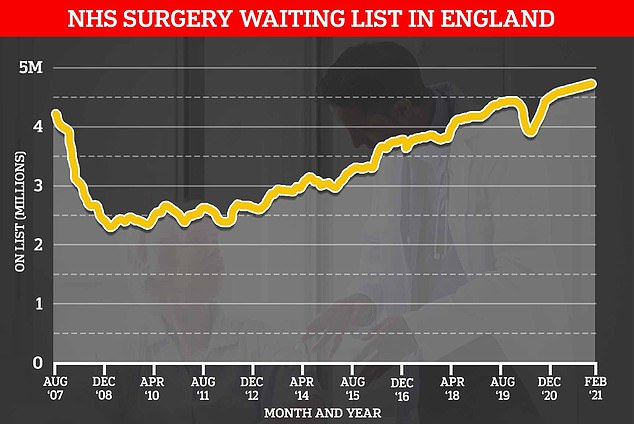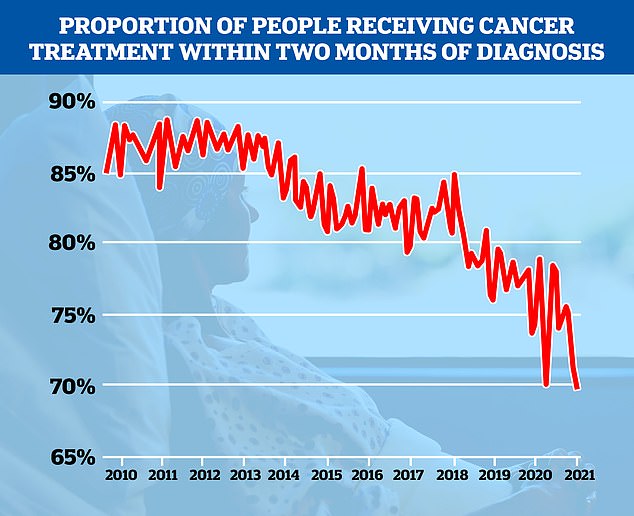Boris Johnson promises NHS will get ‘all the funding it needs’ to get through Covid backlog as number waiting for routine treatment hits ANOTHER record-high with 4.7million patients on the list
- 387,885 people have now waited more than a year for hospital treatment
- 30.3% of people diagnosed with cancer are waiting more than two months
- Medical professionals have lamented the ‘brutal’ effect of the pandemic
Boris Johnson today promised the NHS would ‘get all the funding it needs’ to fight the Covid backlog, with a record 4.7million patients in England now on the waiting list for routine treatment.
The Prime Minister pledged to help the health service back to its feet, as official data showed 400,000 people have waited over a year for surgery.
And the proportion of cancer patients who hadn’t been treated within the two month target after being diagnosed has also jumped to a record 30.3 per cent.
Medics said NHS England’s performance figures laid bare the true toll of the Covid pandemic on hospitals, which were forced to turf out patients with other illnesses during the national lockdowns.
Cancer charities described coronavirus as being ‘catastrophic’ for treatment. While MPs called for an NHS rescue plan to cut down waiting lists as hospitals scramble to cope with a Covid-induced backlog.
Mr Johnson said during a visit to a military base in Dartmouth, Devon: ‘We do need people to take up their appointments and to get the treatment that they need.
‘We’re going to make sure that we give the NHS all the funding that it needs, as we have done throughout the pandemic, to beat the backlog.’

A record 4.7million people are now waiting for routine hospital treatment, official data showed today as the NHS scrambles to catch up with a Covid backlog

Speaking on a visit to the Britannia Royal Naval College in Dartmouth, Devon, today, Boris Johnson said: ‘We’re going to make sure that we give the NHS all the funding that it needs’
Labour’s Shadow Health Secretary Jonathan Ashworth said today: ‘Ten years of Tory underfunding, cuts and chronic staff shortages left the NHS exposed when the pandemic hit.
‘Patients are now left paying the price with waiting lists at record highs.
‘Labour is calling for an NHS rescue plan to bring down waiting lists and ensure patients can receive the quality care they deserve.’
Figures from NHS England show 387,885 people were waiting more than a year for treatment in February.
For comparison, the figure for the same month in 2020 — before Covid spiralled out of control — was 1,613.
Almost 4,000 Covid patients were being admitted to hospital every day in England during the peak of the second wave in January. Rates fell in February, following the effect of lockdown restrictions and vaccination.
It has now been five years since the NHS met the Government’s target of ensuring all patients receive planned treatment.
Tim Mitchell, vice president of the Royal College of Surgeons of England, said: ‘The NHS had a brutal start to the year because of the second wave of Covid, and this is reflected in today’s figures.
‘Although we did see the number of patients with Covid decline in February, hospitals were still under huge pressure due to having to separate Covid and non-Covid care, staff having to isolate or being ill with the virus, and the massive resource needed to support the essential national vaccination effort.
‘Although the most urgent operations, for cancer and life-threatening conditions, went ahead, hundreds of thousands of patients waiting for routine surgery such as hip and knee operations, cochlear implants and vascular operations had their treatment cancelled or postponed.
‘387,885 patients have now been waiting over a year for planned treatment. That is a year of uncertainty, pain, and isolation.
‘People have been patient as they’ve seen the battering the pandemic has given the NHS, but how much longer can they be expected to wait?’
He added: ‘Hitting the inauspicious milestone of a half a decade since the Government’s 18-week target for planned treatment was last met, reminds us the NHS’ capacity problem predates the pandemic.
‘We already had too few beds and not enough staff to keep wider services, such as planned operations, going through hard winters and flu outbreaks.
‘The symptoms were there even before the pandemic, but the problem has now become ‘chronic’ and needs ‘long-term treatment’.
‘As we try to get the NHS back on its feet, we must consider how to future-proof our health service, so that vital and life-changing operations can continue, no matter what comes our way.
‘We need a New Deal for Surgery, with investment on a scale last seen in the 2000s, to get back on track meeting NHS waiting time standards.’
The total number of people admitted for routine treatment in hospitals in England was down 47 per cent in February 2021, compared with a year earlier.
Some 152,642 patients were admitted for treatment during the month, compared with 285,918 in February 2020.
Because 2020 was a leap year, February contained 29 days rather than the usual 28 days. But the extra day will make little overall difference to the figures.
The year-on-year decrease recorded in January was 54 per cent, while in December 2020 the drop was 25 per cent.
Dr Susan Crossland, president of the Society for Acute Medicine, said: ‘This data shows pressure is high and growing despite the fall in Covid cases and this was prior to the country starting to come out of lockdown.
‘Just this week the workload in acute medical units has felt to many like the pre-pandemic ‘eternal winters’ we had been working through for too long.’
She said the ‘scale of pressure on the system’ was best illustrated by separate data showing that 700 A&E patients were left waiting more than 12 hours for treatment in March.
For comparison, the figure was around 330 in March 2019, when casualty units were busier.
Statistics also show 174,624 urgent cancer referrals were made by GPs in February, compared with 190,369 a year before – a year-on-year drop of eight per cent.
But the proportion of suspected cancer patients seeing a consultant within the two-week time target was 90.3 per cent, compared to 92.6 per cent last February. It was just 83.4 per cent in January 2021.
Urgent referrals where breast cancer symptoms were present – though not initially suspected – were down from 13,627 in February 2020 to 12,199 in February 2021, a fall of 10 per cent.
The number of people seeing a specialist for suspected cancer in the first full year of the pandemic is now more than 370,000 lower than in the previous year — a 15 per cent fall.

Fewer than 70 per cent of patients diagnosed with cancer were treated within two months of being referred for urgent tests by their GP — a record low
And there was a six per cent drop in the number of people starting cancer treatment compared with this time last year, with no improvement over 2021.
The total number of people starting treatment between March 2020 and February 2021 is now at least 38,500 lower than expected.
Sara Bainbridge, head of policy at Macmillan Cancer Support, said: ‘Today’s data further illustrates the catastrophic impact of Covid on cancer diagnosis and treatment.
‘Whilst there has been a marginal improvement from January in terms of urgent referrals, the number of people starting treatment remains lower than we’d expect.
‘Tens of thousands of people are still missing a diagnosis due to disruption caused by the pandemic, which could affect their prognosis.
‘It’s vital that cancer services continue to be prioritised and that those with cancer are not forgotten.
‘To address the extensive challenges that lie ahead, the NHS urgently needs a long-term, fully-funded plan for its workforce, ensuring there are more dedicated staff are able to provide the best care for cancer patients, now and in the future.’
NHS England said staff completed almost 2million operations and other elective care in January and February this year, while also providing hospital treatment for nearly 140,000 coronavirus patients.
It said two in five of all patients who have received hospital treatment for Covid were admitted in the first two months of the year.
Data shows 1.9million elective procedures or support for patients took place amid the winter surge of Covid infections and there were some 2.6million A&E visits in that period, NHS England said.
Professor Stephen Powis,
the national medical director for the NHS in England, said: ‘Treating 400,000 patients with Covid-19 over the course of the last year has inevitably had an impact on the NHS but it is a testament to the hard work and dedication of staff that they managed to deliver almost two million ops and procedures in the face of the winter wave and improve waiting times for them along with A&E and ambulance service.
‘It is good to see that people kept coming forward for checks cancer and other care with 22,000 who needed it starting treatment.
‘And the NHS recently announced a £1bn elective recovery fund which will be used to accelerate the restoration of services and treat as many people as possible, so we continue to urge anyone who needs the NHS to come forward so we can help you.’
But Dr Nick Scriven, immediate past president of the Society for Acute Medicine, said: ‘It is becoming clearer that people with chronic illness, such as heart failure, have struggled on throughout the pandemic with community care but have now reached the limit of their endurance and now need hospital inpatient care.
‘Therefore it is imperative to rebuild face-to-face teams in the community as a matter of urgency as these are invaluable for patients with chronic diseases.
‘We must put emphasis on the safe ‘flow’ of patients through hospitals to effective discharge home to enable front door acute and emergency teams to do their jobs with manageable pressure on staff.
‘While no-one wants to see waiting lists increase any further, the priority will always be to ensure the most sick and in need get their care promptly and safely.
‘The job of government and NHS leaders is to make sure systems are in place across the board so that all patients are seen at the right place, by the right person at the right time to really effect change and we are not there yet.’
